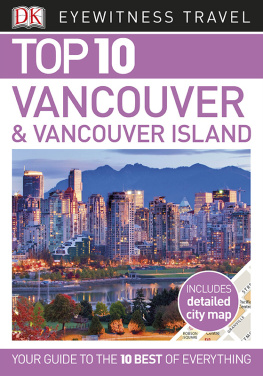 HANDBOOKS
HANDBOOKS
VANCOUVER & VICTORIA
ANDREW HEMPSTEAD
DISCOVER
Vancouver & Victoria
Snowcapped mountains pierce a blue dream of sky. Rocky shorelines and sandy beaches fringe busy waterways. Ancient old-growth forests and brilliant flower gardens overflow with color. Despite sharing this dramatic setting as well as a common history, Vancouver and Victoria offer two distinct personalities.
Big, brash, and ultramodern, Vancouver lies on Canadas west coast mainland, sandwiched between the Coast Mountains and the sparkling Pacific Ocean. With a population of two million, this is the largest city in British Columbia. Explore gleaming world-class museums, vibrant nightlife, and creative cuisine here.
Across the Georgia Strait on Vancouver Island, the smaller, more refined provincial capital of Victoria also takes full advantage of its natural landscape, but in a more genteel form. Expect manicured gardens and afternoon tea. Victorians will be quick to tell you that the weather is nicer and the pace is slower than in Vancouverand they are right on both accounts.
While Vancouver and Victoria get most of the attention, the call of the wild draws locals and visitors alike to venture beyond the suburban sprawl and into the surrounding wilderness. A scenic two-hour drive north of Vancouver is Whistler, best known for world-class skiing and snowboardingincluding the possibility of glacier skiing even in midsummer. Vancouver Island also beckons visitors to the outdoors. Hike the rugged West Coast Trail, surf the waves at Tofino, or dive amid shipwrecks from Nanaimo.
The two cities and their easily accessible surroundings create a world of vacation opportunities. Make reservations at a historical bed-and-breakfast or wilderness lodge. Boil up a feast of crab purchased right on the dock. Try stand-up paddleboarding. Soak up the sights, sounds, and smells of these cities by the sea.
VANCOUVER
Dramatic snowcapped mountains rise high above a modern city clinging to the coastline. A downtown core of century-old buildings and steel-and-glass skyscrapers overlook busy waterways. Sandy beaches and rocky shorelines fringe manicured suburbs. Magnificent old-growth forests and brilliant flower gardens overflow with color. And residents in love with the outdoors eagerly take advantage of its magnificent natural surroundings.
WHISTLER
Its hard to believe that just a few decades ago, this valley was an almost-forgotten ski area with a couple of lifts and a smattering of rustic holiday homes. Today the newly upgraded Sea to Sky Highway leads to a hip, outdoorsy resort town of epic proportions. Chairlifts and gondolas span two mountains, opening up more terrain than any other alpine resort in North America.
VICTORIA
The elegant capital of British Columbia couldnt be more different from its much larger neighbor, Vancouver. Well-preserved buildings line the streets. Totem poles sprout from shady parks. Restored historical areas house trendy shops, offices, and exotic restaurants. Meanwhile double-decker buses and horse-drawn carriages compete for the tourist summer trade.
Inner Harbour, Victoria
VANCOUVER ISLAND
Wherever you travel on this 450-kilometer-long (280-mile) island, the emphasis is on outdoor recreation. A large swath of old-growth forest along the west coast is protected as national park land while local beaches provide surfers with some of Canadas finest waves. Other experiences range from one of the worlds great long-distance coastal hikes to sea kayaking through a protected archipelago.
When to Go
High season is from mid-June to early September. Tourist attractions and hotels are busiest during July and August. During the shoulder seasons, May to mid-June and September, crowds thin out and accommodations reduce rates. The rest of the year is the low season: tourist numbers dwindle, attractions shorten their hours, and lodging prices drastically decrease. In the ski town of Whistler the seasons are reversed: winter (December through April) is high season.
My favorite time to visit is during











 HANDBOOKS
HANDBOOKS














